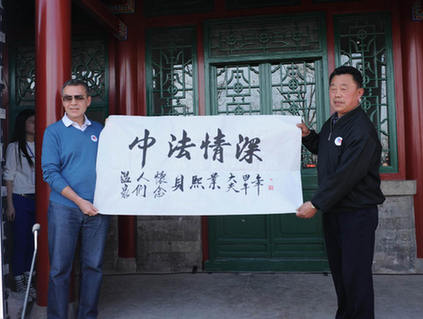Faces of the War
Jean Augustin Bussiere
At the 50th anniversary commemorations of the establishment of Sino-French diplomatic relations in Paris on March 27, Chinese President Xi Jinping said, “We will never forget the contributions made by numerous French friends to the cause of China’s development. One of them is Jean Augustin Bussiere, a French doctor who risked his life to transport much needed medicine by bike to an anti-Japanese base in China.”
Bussiere first came to China in 1912, and returned to France in 1954. During his 40-plus-year stay in China, he worked at the French embassy and later at the French and German hospitals located in Beijing’s Legation Street (now Dongjiaominxiang). Meanwhile, Bussiere was also active in other fields: He co-founded the Sino-French University and, together with eminent educators Cai Yuanpei and Li Shizeng, advanced the campaign for Chinese students to study in France on a work-study basis.
In the Western Hills area of Beijing’s Haidian District is a cluster of historical sites recording Sino-French cultural exchanges. Last year, the Haidian district government initiated a renovation project on these buildings, among which is Dr. Bussiere’s former residence, the Villa of Bussiere.
Bussiere owned two dwellings in Beijing. People from neighboring communities could see the doctor for free. This was a great boon for impoverished, ordinary Chinese back then, especially farmers.
Bussiere sympathized with Chinese people’s suffering during the Japanese aggression against China. Miaofeng Mountain where the Villa of Bussiere nestled was one of the strongholds of the anti-Japanese guerilla forces led by the Communist Party of China. Dr. Bussiere not only regularly treated wounded Chinese soldiers, but also agreed to make his villa a communication station for the CPC in Beijing. Around 1939, Nie Rongzhen, a CPC commander, led his troop to establish an anti-Japanese base in neighboring Hebei Province, where medicines were urgently needed for wounded soldiers. Learning the news, Dr. Bussiere, then in his 60s, risked his life to transfer medicines and medical apparatus from the downtown area to his suburban villa by bike. There he passed them on to the guerrilla forces, so making significant contributions to China’s anti-Japanese campaign.
 |
|
On March 30, 2014, local residents of Beijing’s Western Hills area presented a calligraphic work affirming the profound friendship between China and France to Jean Louis Bussiere, son of Jean Agustin Bussiere, subject of the film The Villa of Bussiere. |
On March 30, a ceremony was held to launch the filming of The Villa of Bussiere, a documentary on Dr. Bussiere’s life. Its aims is to encourage Chinese people to learn more about the French doctor and his relationship with China.
